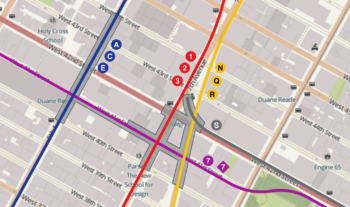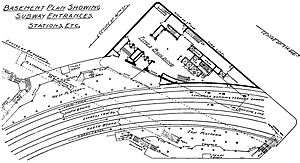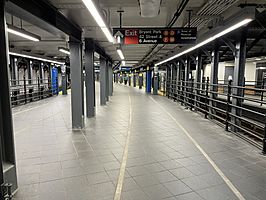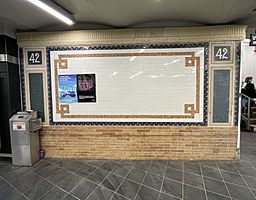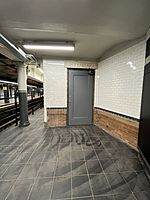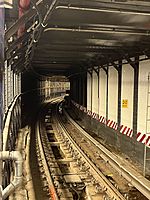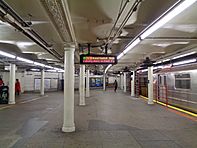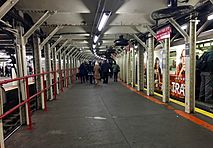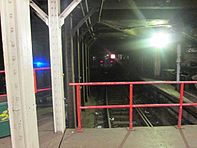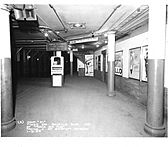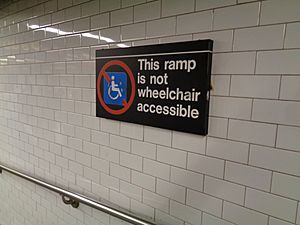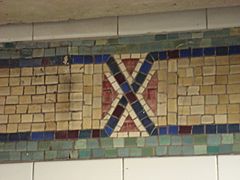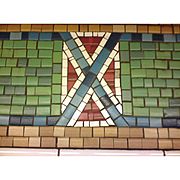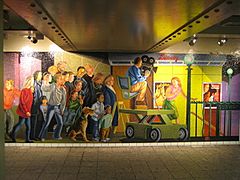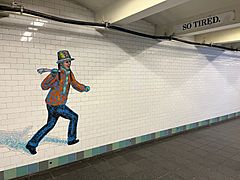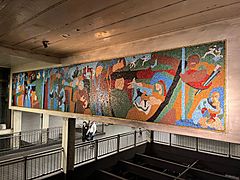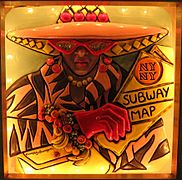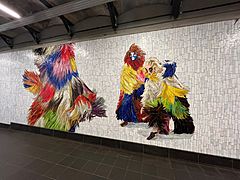Times Square–42nd Street station facts for kids
Quick facts for kids
Times Square–42 Street
|
|||||||||||
|---|---|---|---|---|---|---|---|---|---|---|---|

Entrance to the station at 42nd Street & 7th Avenue
|
|||||||||||
| Station statistics | |||||||||||
| Address | West 42nd Street, Broadway, & Seventh Avenue New York, New York 10036 |
||||||||||
| Borough | Manhattan | ||||||||||
| Locale | Times Square, Midtown Manhattan | ||||||||||
| Coordinates | 40°45′21.6″N 73°59′13.2″W / 40.756000°N 73.987000°W | ||||||||||
| Division | A (IRT), B (BMT, IND) | ||||||||||
| Line | IRT 42nd Street Shuttle BMT Broadway Line IRT Broadway–Seventh Avenue Line IRT Flushing Line |
||||||||||
| Services | 1 alltimes (all times) 2 alltimes (all times) 3 alltimes (all times) 7 alltimes (all times) <7>rushpeak (rush hours until 9:30 p.m., peak direction) N alltimes (all times) Q alltimes (all times) R allexceptnights (all except late nights) W weekdaysonly (weekdays only) S allexceptnights (all except late nights) |
||||||||||
| System transfers | At 42nd Street–Port Authority Bus Terminal: A alltimes (all times) C allexceptnights (all except late nights) E alltimes (all times) At 42nd Street–Bryant Park/Fifth Avenue, daytime (6 a.m. to 12 a.m.) only: 7 alltimes (all times) <7>rushpeak (rush hours until 9:30 p.m., peak direction) B weekdaysonly (weekdays until 11:00 p.m.) D alltimes (all times) F alltimes (all times) M weekdaysonly (weekdays until 11:00 p.m.) |
||||||||||
| Transit connections | |||||||||||
| Structure | Underground | ||||||||||
| Levels | 5 | ||||||||||
| Other information | |||||||||||
| Opened | June 3, 1917 | ||||||||||
| Station code | 611 | ||||||||||
| Accessible | |||||||||||
|
|||||||||||
|
|||||||||||
|
|||||||||||
|
|
|||||||||||
|
Times Square–42nd Street Subway Station
|
|||||||||||
| MPS | New York City Subway System MPS | ||||||||||
| NRHP reference No. | 04001016 | ||||||||||
| Added to NRHP | September 17, 2004 | ||||||||||
The Times Square–42nd Street station is a huge New York City Subway station. It is located right under Times Square in Midtown Manhattan. This station lets you easily switch between different subway lines. These include the IRT 42nd Street Shuttle, the BMT Broadway Line, the IRT Broadway–Seventh Avenue Line, and the IRT Flushing Line. You can also transfer to the IND Eighth Avenue Line one block away.
Many trains serve this station all the time, like the 1, 2, 3, 7, N, and Q trains. The W train runs here on weekdays. The R and 42nd Street Shuttle (S) trains run here most of the time. During busy hours, special ⟨7⟩ trains also stop here. There's even a free walkway to the 42nd Street–Bryant Park/Fifth Avenue station, open during the day.
The first part of this station, the shuttle platforms, opened on October 27, 1904. It was one of the first 28 stations in the New York City Subway system. Over the years, more lines were added. The Broadway–Seventh Avenue Line platforms opened in 1917, followed by the Broadway Line in 1918, and the Flushing Line in 1928. The station has been updated many times. In 2004, it was added to the National Register of Historic Places, which means it's an important historical site. The shuttle station was recently updated again in the early 2000s.
This station complex is one of the busiest in the whole subway system. In 2019, over 65 million passengers used it! Most of the station is accessible for people with disabilities.
Contents
History of the Times Square Subway Station
The Times Square station has grown a lot over time. Different subway lines were connected to make it easier for people to transfer. For example, the 42nd Street Shuttle and the Broadway–Seventh Avenue Line were connected in 1917. The Flushing Line joined in 1927.
In 1932, a long walkway was opened. It connected the IND Eighth Avenue Line's 42nd Street–Port Authority Bus Terminal station to the IRT platforms. At first, you had to pay extra to use this connection. But in 1948, transfers between the IRT and BMT lines became free. In 1988, the walkway to the IND station also became free to use.
Building the First Subway Line
Planning for New York City's subway started way back in 1864. The first subway line was approved in 1900. Engineers designed a line that would run from New York City Hall up to the Upper West Side. From there, it would split into two branches heading to the Bronx.
The section of the subway under 42nd Street and Times Square began construction in 1901. By late 1903, the subway was almost ready. In April 1904, Longacre Square was renamed Times Square. This was done to give the new subway station a unique name.
The Times Square station officially opened on October 27, 1904. It was one of the first 28 stations in the New York City Subway. Just three years later, it was the third busiest subway station in the city. It was also the busiest local station, with 30,000 riders every day.
Expanding the Station
To handle more passengers, the subway platforms were made longer starting in 1909. This allowed for longer trains with more cars. These improvements helped increase the subway's capacity by 25 percent.
The Dual Contracts
In 1913, new plans were made to expand the subway system. These plans, called the "Dual Contracts," involved two main subway companies: the IRT and the BRT (later BMT). The idea was to create an "H"-shaped subway system. The original line under 42nd Street would become a shuttle service. New platforms would be built for the Broadway–Seventh Avenue Line.
The new Broadway–Seventh Avenue Line station opened on June 3, 1917. It was part of an extension of the IRT line. On August 1, 1918, the "H system" officially started. The old main line platforms became part of the 42nd Street Shuttle.
The Broadway Line station, built by the BRT, also opened in 1918. It was designed to be an express station. This was important for people wanting to travel quickly through the Theater District.
The Flushing Line
The Dual Contracts also included finishing the Steinway Tunnel. This tunnel would be part of the new IRT Flushing Line. The Flushing Line was planned to run under 41st and 42nd Streets in Manhattan. It would connect Times Square to Queens.
In 1920, it was announced that the Flushing Line would extend to Times Square. This would help reduce crowding on the 42nd Street Shuttle. The new Times Square station for the Flushing Line was built deeper underground. It opened on March 14, 1927.
Mid-20th Century Changes
In 1940, the city government took over the operations of both the BMT and IRT subway lines. This meant the city now ran the entire New York City transit system.
In the 1950s, the Flushing Line platforms were made longer. This allowed them to fit 11-car trains. Some entrances were also changed or rebuilt during this time.
In the 1980s, the MTA started renovating the BMT station. They fixed its structure and appearance. On August 1, 1988, the walkway connecting the IND Eighth Avenue Line station to the IRT/BMT complex finally became free to use.
Recent Renovations
The Times Square subway complex underwent a huge renovation starting in 1994. The goal was to make the station less crowded and safer for riders. This involved widening corridors and adding new elevators and escalators. These changes made the station accessible for people with disabilities.
A new main entrance opened in July 1997. It has a bright sign with train symbols and the word "Subway." This entrance also includes an elevator and escalators. The renovation cost over $257 million by 2004.
During these renovations, some old storage rooms were turned into offices. A large mezzanine area was also widened. The passageway connecting to the IND station was also refurbished. In 2004, new public bathrooms were opened.
Shuttle Station Upgrade
A major part of the renovation was upgrading the 42nd Street Shuttle platform. The old shuttle platform was replaced with a new, wider island platform. This new platform is 28 feet wide and 360 feet long. It was built between tracks 1 and 4. This project made the shuttle station accessible for people with disabilities.
The shuttle station was temporarily closed in mid-2020 for this work. The new platform opened on September 7, 2021. A new entrance with a wide staircase and an elevator also opened in May 2022. This new entrance has a canopy with 238 triangular glass frames. They look like the crystals on the New Year's Eve Crystal Ball.
Other Updates
In 2015, the Flushing Line was extended one stop west to 34th Street–Hudson Yards. This meant the old lower level of the 42nd Street–Port Authority Bus Terminal station had to be removed.
In 2022, the MTA announced plans to add platform screen doors to the IRT Flushing Line platforms. These doors will help improve safety by separating passengers from the tracks.
Station Incidents
The station has experienced a few incidents over the years. In 1960, a bombing at the station injured 33 people. Another incident occurred in 2017 when a device partially exploded in a passageway.
Station Layout
The Times Square station is named after The New York Times newspaper. The Times headquarters, built by Adolph S. Ochs, used to have the original subway station in its basement.
This complex is made up of four separate stations. It is also connected to the 42nd Street–Port Authority Bus Terminal station. The shallowest station is the 42nd Street Shuttle platform, about 20 feet below the street. The IRT Broadway–Seventh Avenue Line station is 40 feet deep. The BMT Broadway Line station is 50 feet deep. The deepest station is the IRT Flushing Line, which is 60 feet below street level.
The Times Square–42nd Street and 42nd Street–Port Authority Bus Terminal stations are mostly wheelchair-accessible. However, the ramp connecting the two parts of the complex is not.
Station Levels
The station has several levels of mezzanines (large open areas) and passageways. The main mezzanine is near the shuttle platforms. It has four walkways arranged in a trapezoid shape. This mezzanine has glass-tiled walls and mosaic bands. You might even see performers from "Music Under New York" here.
There's a smaller mezzanine near the south end of the BMT platforms. It leads to exits on 40th Street.
Below the IRT Broadway–Seventh Avenue Line platforms, there's another mezzanine. It connects to a steep ramp that leads to the passageway for the IND Eighth Avenue Line platforms. This 600-foot-long passageway is mostly flat but has steep ramps at both ends.
Exits
There are many ways to enter and exit this large station. Some exits lead to the 42nd Street-Port Authority Bus Terminal station on Eighth Avenue.
Several exits serve most or all of the subway lines in the complex. You can find exits inside buildings on 42nd Street. There's also an elevator and escalator bank inside the Times Square Tower. One street stair goes to the southeast corner of Broadway and 42nd Street.
On 41st Street, there are exits into buildings and street stairs. There are also exits on 40th Street that serve specific lines.
Some exits have been closed over the years. For example, a stair to the southwestern corner of 43rd Street and Broadway was closed in 2019. Many of the station's entrances were originally built inside other buildings.
IRT 42nd Street Shuttle Platform
|
Times Square
|
|||||||
|---|---|---|---|---|---|---|---|

Shuttle platform facing track 1
|
|||||||
| Station statistics | |||||||
| Division | A (IRT) | ||||||
| Line | IRT 42nd Street Shuttle | ||||||
| Services | S allexceptnights (all except late nights) | ||||||
| Structure | Underground | ||||||
| Platforms | 1 island platform | ||||||
| Tracks | 2 | ||||||
| Other information | |||||||
| Opened | October 27, 1904 | ||||||
| Station code | 468 | ||||||
| Accessible | |||||||
| Opposite-direction transfer available | N/A | ||||||
| Former/other names | 42 Street | ||||||
| Station succession | |||||||
|
|||||||
The Times Square station for the 42nd Street Shuttle has one island platform. This platform was finished in 2021. It is 28 feet wide and 360 feet long. At the east end, there's a passageway to the 42nd Street–Bryant Park station.
The 42nd Street Shuttle runs almost all the time. The next station to the east is Grand Central.
The new island platform replaced an older design from 1904. The original station had four tracks and two side platforms. Over time, parts of the old platforms were changed or removed. For example, one track was replaced by a temporary wooden platform. The old track 3 was removed in 2020 to make way for the new island platform.
The old platforms had curves, so special "gap fillers" were used. These helped bridge the space between the platform and the train.
Station Design
Like other early IRT stations, this one was built using a "cut-and-cover" method. This means they dug a trench, built the station, and then covered it up. The platforms are made of concrete slabs.
The original station had decorative blue and pink tiles. It also had colorful designs and plaques. Some parts of the original walls remain, showing brick and white tiles. There were even old doorways that led to nearby buildings like the Knickerbocker Hotel.
BMT Broadway Line Platforms
|
Times Square–42 Street
|
|||||||||||||
|---|---|---|---|---|---|---|---|---|---|---|---|---|---|
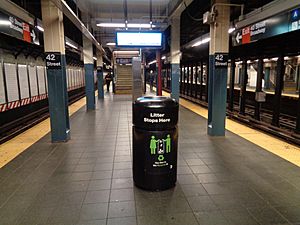
Uptown platform
|
|||||||||||||
| Station statistics | |||||||||||||
| Division | B (BMT) | ||||||||||||
| Line | BMT Broadway Line | ||||||||||||
| Services | N alltimes (all times) Q alltimes (all times) R allexceptnights (all except late nights) W weekdaysonly (weekdays only) |
||||||||||||
| Structure | Underground | ||||||||||||
| Platforms | 2 island platforms cross-platform interchange |
||||||||||||
| Tracks | 4 | ||||||||||||
| Other information | |||||||||||||
| Opened | January 5, 1918 | ||||||||||||
| Station code | 011 | ||||||||||||
| Accessible | |||||||||||||
| Opposite-direction transfer available | Yes | ||||||||||||
| Station succession | |||||||||||||
|
|||||||||||||
The Times Square–42nd Street station on the BMT Broadway Line is an express station. It has four tracks and two island platforms. The N and Q trains stop here all the time. The R train stops here most of the time. The W train runs here on weekdays.
To the north, the next local station is 49th Street. The next express station is 57th Street–Seventh Avenue. To the south, the next station is 34th Street–Herald Square.
You can reach the main mezzanine from each platform using stairs and an elevator. At the very south end of each platform, stairs lead to a smaller mezzanine.
The station's walls have white square ceramic tiles. There's also a colorful pattern running along the top of the walls. Plaques with a white "42" tile are placed every 15 feet.
IRT Broadway–Seventh Avenue Line Platforms
|
Times Square–42 Street
|
|||||||||||
|---|---|---|---|---|---|---|---|---|---|---|---|
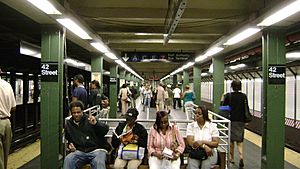
Downtown platform
|
|||||||||||
| Station statistics | |||||||||||
| Division | A (IRT) | ||||||||||
| Line | IRT Broadway–Seventh Avenue Line | ||||||||||
| Services | 1 alltimes (all times) 2 alltimes (all times) 3 alltimes (all times) |
||||||||||
| Structure | Underground | ||||||||||
| Platforms | 2 island platforms cross-platform interchange |
||||||||||
| Tracks | 4 | ||||||||||
| Other information | |||||||||||
| Opened | June 3, 1917 | ||||||||||
| Rebuilt | 1998-2002 | ||||||||||
| Station code | 317 | ||||||||||
| Accessible | |||||||||||
| Opposite-direction transfer available | Yes | ||||||||||
| Station succession | |||||||||||
|
|||||||||||
The Times Square–42nd Street station on the IRT Broadway–Seventh Avenue Line is an express station. It has four tracks and two island platforms. The 1, 2, and 3 trains stop here all the time. The 3 train also ends its journey here late at night.
To the north, the next local station is 50th Street. The next express station is 72nd Street. To the south, the next station is 34th Street–Penn Station.
The platforms are 510 feet long. Stairs connect the platforms to other subway lines. There are also stairs and an elevator that lead to the mezzanines above and below the platforms.
The station's walls have white square ceramic tiles. A colorful pattern runs along the top of the walls. Plaques with a stylized "T" are placed regularly along the walls.
Just south of the station, there's a fifth center track. This track is used for trains that need to turn around, especially the 3 trains at night.
IRT Flushing Line Platform
|
Times Square–42 Street
|
|||||||||
|---|---|---|---|---|---|---|---|---|---|
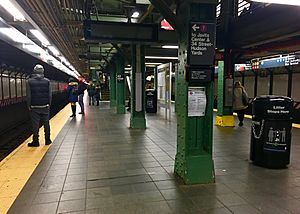
The IRT Flushing Line platform
|
|||||||||
| Station statistics | |||||||||
| Division | A (IRT) | ||||||||
| Line | IRT Flushing Line | ||||||||
| Services | 7 alltimes (all times) <7>rushpeak (rush hours until 9:30 p.m., peak direction) | ||||||||
| Structure | Underground | ||||||||
| Platforms | 1 island platform | ||||||||
| Tracks | 2 | ||||||||
| Other information | |||||||||
| Opened | March 14, 1927 | ||||||||
| Station code | 467 | ||||||||
| Accessible | |||||||||
| Opposite-direction transfer available | Yes | ||||||||
| Station succession | |||||||||
|
|||||||||
The Times Square–42nd Street station on the IRT Flushing Line has one island platform and two tracks. It is located deep under West 41st Street. The 7 train stops here all the time. The ⟨7⟩ train stops here during busy hours.
The station is between 34th Street–Hudson Yards to the west and Fifth Avenue to the east. Stairs, escalators, and an elevator connect the platform to different mezzanines.
The platform is made of concrete slabs. It has columns spaced every 15 feet. The walls along the tracks have white square ceramic tiles. There's a colorful pattern along the top of the walls. Plaques with a white "TS" tile are placed every 15 feet.
The tracks continue west beyond the station to the 34th Street station. These tracks were updated as part of the 7 Subway Extension project.
Artwork in the Station
Original Designs
The first architects of the IRT, George Lewis Heins and Christopher Grant LaFarge, designed the original Times Square Station. They often used symbols to honor a neighborhood. Later, Squire Vickers continued this tradition.
Some of the original tile designs in the IRT parts of the station look like the Confederate flag. Scholars believe this was a nod to Adolph S. Ochs, the owner of The New York Times. His newspaper built its headquarters right above the subway station in 1904. In 2017, the Metropolitan Transportation Authority decided to cover these tiles.
Modern Artworks
The station complex features several artworks from the MTA Arts & Design program.
- In 1991, Norman B. Colp created The Commuter's Lament or A Close Shave. This is a series of signs on the roof of the 41st Street passageway. They read: Overslept/So tired/If late/Get fired/Why bother?/Why the pain?/Just go home/Do it again. The last sign shows a bed.
- Jack Beal created two mosaic murals: The Return of Spring (2001) and The Onset of Winter (2005). They show the Greek myth of Persephone in a subway setting.
- Jacob Lawrence created a mosaic mural called New York in Transit (2001). It shows different parts of New York City life. This was Lawrence's last public artwork.
- Roy Lichtenstein created Times Square Mural (2002). This large artwork shows an elongated car moving through a subway station.
- Times Square Times: 35 Times by Toby Buonagurio (2005) is in the mezzanine. It has tiles showing fashion, performing arts, and street life.
- Jane Dickson created Revelers, a mosaic artwork in the lower mezzanine. It shows about 70 life-size people moving in groups.
- The shuttle station has three artworks by Nick Cave: Each One, Every One, and Equal All (all 2021). Every One in the passageway has mosaics and digital screens. They show figures in "Soundsuits", which are special costumes.
See also
 In Spanish: Times Square–Calle 42 (metro de Nueva York) para niños
In Spanish: Times Square–Calle 42 (metro de Nueva York) para niños





